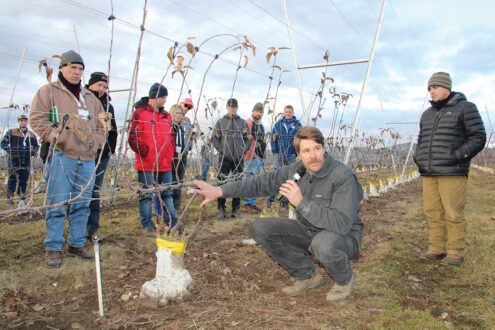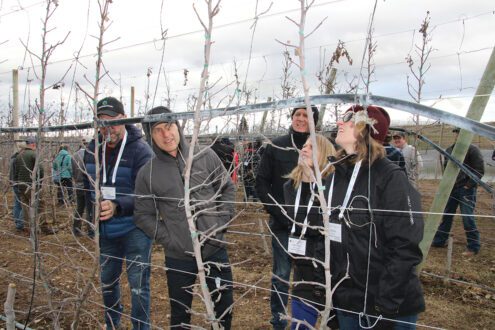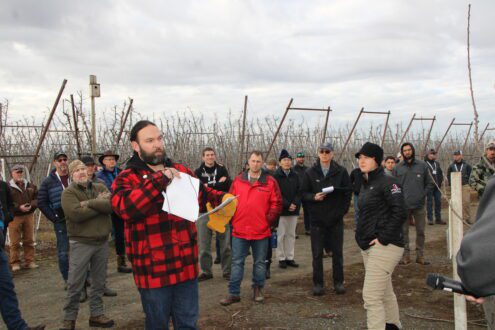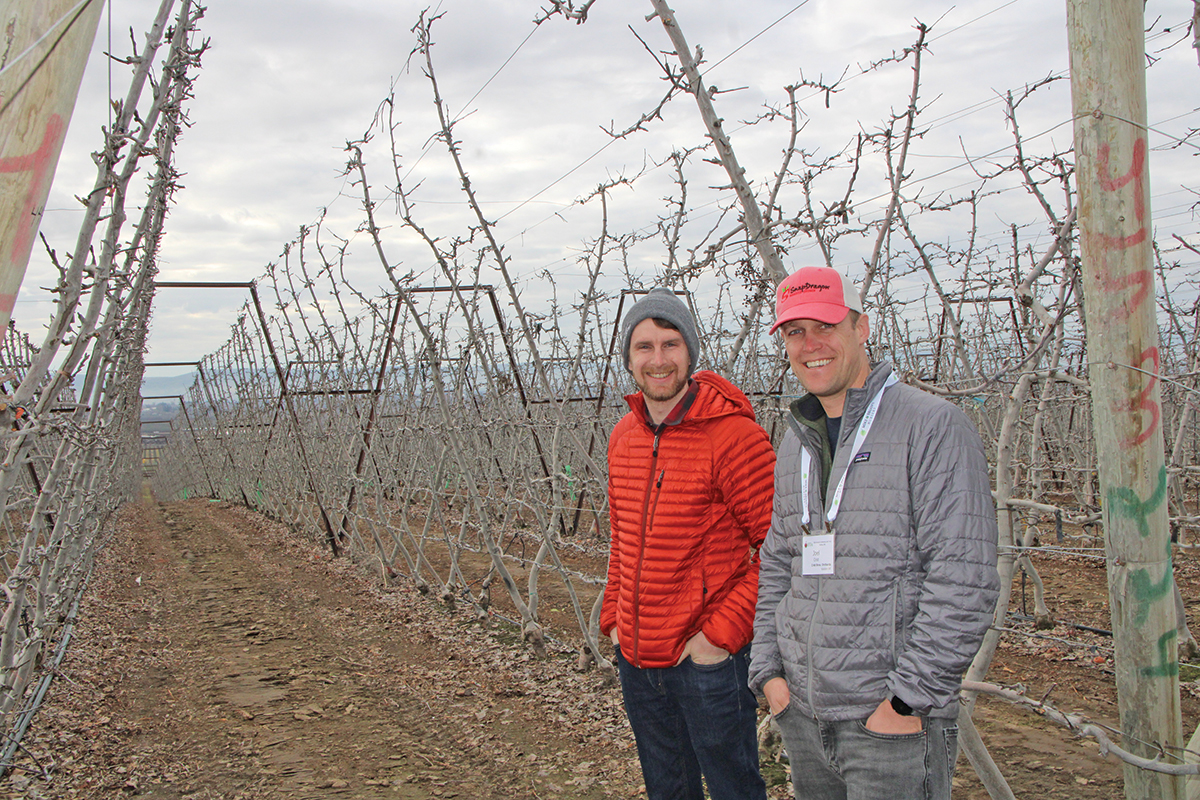
Apr 23, 2024IFTA Yakima Valley tour provides orchard insights
During the International Fruit Tree Association (IFTA) conference and orchard visits, participants viewed the variety of fruit training systems and crop load management programs that Washington apple growers employ.
Participants visited a half-dozen farms in Washington’s upper and lower Yakima Valley during the conference, Feb. 11-14 in Yakima.


The tours, which included visits to leased orchard land on parts of the Yakima Indian Reservation near Toppenish and Wapato, supported the show’s theme of Bridging the Gap Between Information and Action. Bud census Bud counting is important for Chiawana Orchards.
At the company’s Rosinbum farm near Cowiche west of Yakima, Bruce Allen, partner, said that as soon as the leaves are off the tree, the company gauges the percentage of floral buds. Chiawana distinguishes between spur buds and dards (lateral shoots). The focus forced Chiawana to slightly adjust pruning practices in some orchards, depending on the spurs and buds balance.
When he first examined V-type trellis systems, Allen wondered how to pick inside the Vs, where about 20% of the fruit is. Chiawana still grows on Vs, but has added vertical systems, for ease of production.
“If they ever do get to robotic harvesting, they (vertical systems) are going to be much easier to adapt to and have a much higher efficiency or recovery rate of the fruit because the fruit is totally accessible,” Allen said.
Robot-ready system
At Allan Bros.’ Grandview Ranch, Luke Anderson, area manager, and Suzanne Bishop, research and development director, said the company is trying to grow targeted fruit by experimenting with different systems.


“Our goal is to maximize targeted fruit per acre,” Anderson said. Tour participants viewed Envy and Honeycrisp on multi-leader systems and Jazz on a vertical system, as well as cherries on a formally trained V-type trellis system.
In general, the company plants V-type trellis systems. “If we were to plant tomorrow, it would be V trellis based off production per-acre,” Bishop said. “That’s what we’ve come to like. The other thing that we’re looking at in the future is trying to figure out how to be, let’s just say, robot ready and allow for mechanization to come in.
“As we learned from the different workshops earlier, a lot of the machines work better on a vertical wall,” she said. “So, I don’t think we’re saying goodbye completely to a vertical wall, we’re kind of just pausing it. We know this works, and so we’ll stay with a V trellis for now. But we might convert to a more of a fruiting wall later.”
Grafting experience
First grafting a multileader system in 2011, Sundquist Fruit has been experimenting with additional leaders in some of its blocks. Last spring, Sundquist grafted Cosmic Crisp WA 38 onto Brookfield Galas planted in 1996 on M26 rootstock. The grafting and training have helped improve tree growth faster than normal. The goal is to balance vigor and produce 7,000 to 8,500 leaders per acre, said Andrew Sundquist during a tour of the company’s Moxee groves.
At another Cosmic Crisp block, Sundquist root prunes both sides of trees. The company experimented with pruning management, allowing limbs to grow too long or or cut them too short, producing varying results by picking crews. Sundquist worked to make the process more uniform so pruners could easily move from one block to the next following a basic set of rules throughout the orchard.
“What we’ve been trying to do is to get back to more uniformity and moving to a system where everything is tied to the leader,” Sundquist said. “It’s a lot easier to teach these uniform systems. Plus, the more leaders you have, generally, the more productive you are and the less variability you have.”
Labor bonus
Persuading longtime labor to change thinning practices is a challenge at Cornerstone Ranches in Toppenish.


“If you prune it correctly, you cut your costs quite a bit,” said Graham Gamache, owner. “One of the hurdles that we’re battling against is we have a legacy pruning crew. A lot of the same people have been working here for a long time and so when you introduce a new tactic to them, they’re hesitant to adopt it.”
Technology could help reduce thinning costs.
“We’re trying to get away from the labor,” said Javier Ramos, apple manager. “Because we always have a lack of people working in the field, I’m always thinking about mechanization of the thinning.”
Discipline requirement
In its Grandview blocks, Washington Fruit Growers runs an intense cropload management system for varieties including Fujis and Galas grown via formally
trained V-type trellis and multileader systems.
“The biggest thing for me is the uniformity of those multileader systems,” Ramon Cuevas, manager, said. “You’ve got to be really disciplined when you start it. If you’re going to do multileader, you’ve got to make sure you select similar branches that you’re going to bring out and be disciplined to the spacing in between.”


Despite extra work required to teach picking crews how to properly check the buds, harvest bonuses have helped incentivize the process.
“We have three opportunities to get exactly what we want out of this deal, and the quicker we can get to our number, what we’ve seen is we get a better fruit size and better quality of fruit,” Cuevas said. “Our philosophy is: Get it up to the top wire as fast as we can, but in the meantime, take what the tree gives us.”
Changing grove
Sean Gilbert, president of Gilbert Orchards, talked about the challenges of growing apples on an orchard that has been in constant development since he was a child helping his father train young Galas. The Gilberts transformed the old orchard with 30 by 40 inch spacings into an economical modern Honeycrisp orchard on M7 rootstock.
Focusing on color development has underscored the importance of formal training, he said, eliminating “cheater limbs” that don’t conform to the system.
“We’ve learned we have to manage that very carefully,” Gilbert said. “And those of us that enjoyed the early years on Honeycrisp, we could get by without having a very high-colored Honeycrisp, and we could still sell it into the market for decent money.”
— Doug Ohlemeier, assistant editor
Top photo: Andrew Sundquist of Sundquist Fruit discussed fruit tree grafting.














